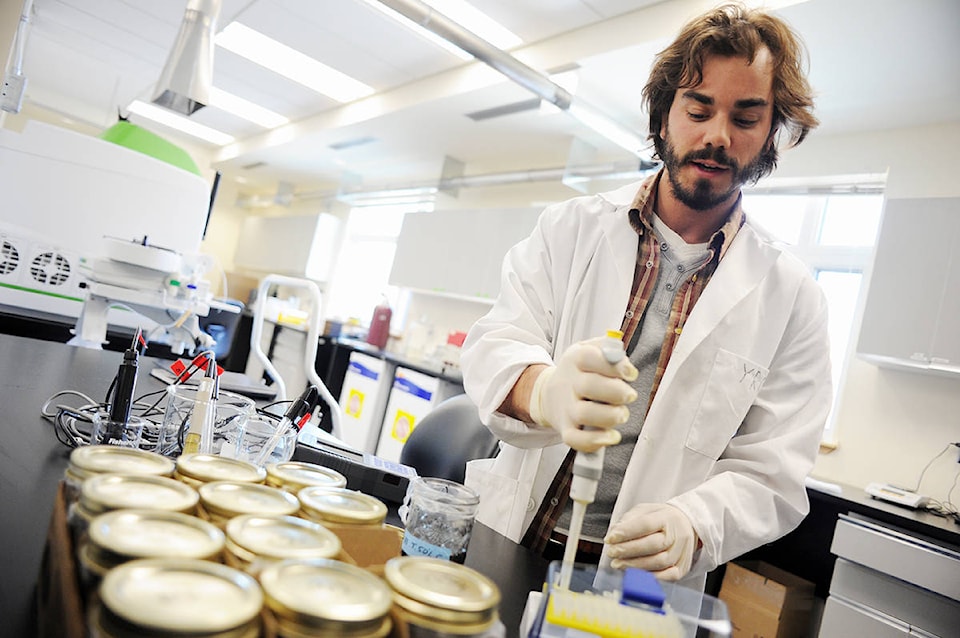Yukon research into cleaning heavy metals out of contaminated mine water using bacteria is getting attention from an international science journal.
The paper details how bacteria, combined with the right amount of molasses and methanol, can be used to clean old mine sites even in the Yukon’s cold weather. It was published this summer in Mine Water and the Environment, the journal of the International Mine Water Association.
Lead author Guillaume Nielsen said the Yukon research was the first of its kind to be done in the North.
“(Getting published) means a lot, considering the fact that probably scientists around the world are going to read this paper and work with it to try to bring the project to the next step.”
The paper details the first stage of the research performed at a Yukon Research Centre lab in 2015. The work found that even in the North, the right concoction resulted in 95 per cent of the zinc and up to 99 per cent cadmium being removed after 90 days.
Similar methods are often used in the South, Nielsen said.
“Here in the North we tested the technology used in the South, and with the right amount of carbon, with the right conditions in bioreactors, it works.”
The process starts with digging up dirt that will naturally include bacteria native to the territory. Nielsen got his from Crystal Creek, in the Keno Hill mining district.
That dirt was placed in a small lab-scale bioreactor with about a litre of contaminated mine water.
The right combination of molasses and methanol is added to the bioreactor to “feed” the bacteria, which then go to work.
“There is different carbon sources that we can use and some are better than others to keep the bacteria happy,” Nielsen said.
The Yukon experiments were conducted at 5 C, the year-round temperature of underground water flowing through the mine site.
Down south, similar results happen at temperatures of 23 C to 26 C.
The cold does affect the bacteria’s efficiency, Nielsen said. But the right combination of other ingredients can mitigate that effect.
“Does it work as well? No. But does it work enough? Yes. We can remove 95 to 99 per cent of cadmium which is more than OK to meet the discharge limits imposed by the water use license.”
Using bacteria is more environmentally friendly than the current way of cleaning the water, he said.
Right now mine water is mostly treated through an active process using lime.
Lime, mixed with the acid mine water raises the PH level of the concoction and the heavy metals sink to the bottom to be removed.
“The first thing you need to do to treat water coming up from a mine is to open a new mine to mine lime,” Nielsen said. “Then you have to transport the lime. You need to store it, which is hazardous.”
Unlike that technique, the method Nielsen and the team researched is passive, he said.
The research was done as a partnership between the college and Alexco Resources.
The mine company’s environmental group is responsible for remediating the Keno Hill silver mine district.
The published paper only focuses on the first stage of the research, done in a lab in 2015. Since then a larger pilot project was completed in the area. In that case researchers used two 200-litre bioreactors.
“We were able to treat around 100 litres per week,” Nielsen said.
He’s not providing much detail about how that pilot project went: a second research paper is in the works.
“It worked as well as lab-scale.”
Researchers also extracted DNA from the bioreactors to get more details about characteristics of the bacteria.
“The mine water treatment adventures continue,” Nielsen said.
Alexco is working on its own full-scale pilot project at the old Silver King mine site using what Nielsen learned.
The company reports that similar results being obtained in its tests, according to a press release from Yukon College. No one from the company was available to comment for this story.
Nielsen couldn’t say how much it would cost to set up a passive system large enough to clean all the water coming out of the Keno site.
As a scientist he can just show that the method works, he said.
“I can guess, based on the fact that you use less labour, and (fewer) chemicals that it’s going to be cost competitive at least.”
Contact Ashley Joannou at ashleyj@yukon-news.com
